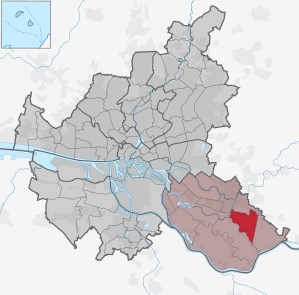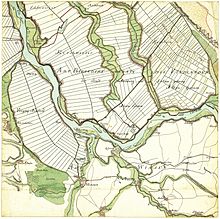Hamburg-Curslack
|
Curslack district of Hamburg |
|
|---|---|
| Coordinates | 53 ° 27 '31 " N , 10 ° 12' 57" E |
| surface | 10.6 km² |
| Residents | 4036 (Dec. 31, 2019) |
| Population density | 381 inhabitants / km² |
| Post Code | 21039 |
| prefix | 040 |
| district | Bergedorf |
| Transport links | |
| Highway |
|
| bus | 225, 328, 321, 327, 124, 223, 427 |
| Source: Statistical Office for Hamburg and Schleswig-Holstein | |
Curslack ( Low German : Curslaak ) is a Hamburg district in the Bergedorf district . It is one of the four districts that together make up the Hamburg Vierlande . Parts of the old village are under monument protection.
history
The place name Curslack ( Low German : Corslak ) goes back to the word Cuwerslake , which designates “a low marshland that is heavily exposed to the ingress of water”. Kuren stands for “seeping” and lake for “moist meadow”. In fact, the area was regularly flooded until the 1950s, when the Tatenberger Schleuse was built . For this reason, the walls of the old Curslacker houses are tiled, so the water could not cause much damage.
Curslack was first mentioned in a document when it formed a dike association with Altengamme in 1188 . In 1420, Curslack received its first connection to Hamburg after Hamburg and Lübeck conquered the city of Bergedorf and, in addition to Bergedorf, also administered Curslack jointly ("both cities"). In 1443 there was a connection to Bergedorf through the Schleusengraben, which was mainly used to transport wood from the Sachsenwald to the Elbe. The Vierlande , consisting of Curslack, Altengamme, Neuengamme and Kirchwerder , formed in the middle of the 16th century. The proximity to Hamburg turned out to be economically lucrative, as the farmers were able to sell their products well in the city. In 1570 the Curslacker Heerweg was built, which represented the connection between Bergedorf and the Zollenspieker Elbe crossing. The Curslacker Heerweg still exists today. Over the centuries the people of Curslack specialized in horticulture and floriculture.
In 1868 the two-city rule over Curslack ended. Hamburg acquired Lübeck's ownership rights and incorporated the previously Lübeck part of Bergedorf, including the associated areas, into the territorial lordship of the marshland formed in 1830 . As part of the Greater Hamburg Act , Bergedorf and the Vierlande lost their communal independence in 1937 and became part of the unified municipality of Hamburg. Curslack has been a district in the newly created Bergedorf district since 1949.
From 1912 the four-country railway ran from Bergedorf to Zollenspieker. With their own stop, the Curslackers had access to this mode of transport, which ended in 1953.
statistics
- Minor quota: 21.0% [Hamburg average: 16.3% (2017)].
- Elderly rate: 15.2% [Hamburg average: 18.2% (2017)].
- Proportion of foreigners: 17.7% [Hamburg average: 17.1% (2017)].
- Unemployment rate: 4.7% [Hamburg average: 5.2% (2017)].
The average income per taxpayer in Curslack is 41,512 euros annually (2013), the Hamburg average is 39,054 euros.
politics
For the election to Hamburg citizenship , Curslack belongs to the constituency of Bergedorf . The 2015 state election led to the following result:
- SPD 50.8% (+6.3)
- CDU 18.9% (-10.5)
- Greens 11.4% (+1.1)
- FDP 6.1% (-0.7)
- AfD 6.1% (+6.1)
- Left 4.2% (+0.5)
- Other 2.5% (–2.8)
Attractions
St. Johannis Church
The church building is mentioned in a document from 1306, at that time a field stone building. The current building dates from 1599/1603.
Rieckhaus (open-air museum)
The Rieckhaus is a branch of the Altona Museum . As an open-air museum , it conveys the living and working methods of the march farmers before industrialization (16th to 19th centuries). The main building impressively reflects the way of life of a wealthy rural upper class.
Economy and Infrastructure
Despite increasing home construction, Curslack has retained its village character. The landscape is characterized by the greenhouses of the floriculture companies.
Waterworks
In Curslack standing waterworks company Hamburg Wasser . It was built in 1928 and replaced by a new building in 2004. More than 200 shallow wells and 14 deep wells (12 to 106 m deep) are located in a fenced, seven kilometer long and about 100 m wide strip in Curslack and Altengamme . The average daily delivery volume is 60 million liters. This makes it the waterworks with the largest output for the water supply in Hamburg . It supplies 350,000 inhabitants in the center, in the southeast and partly in the east of the city.
Part of the district is fallow land, which is designated as a water protection area because of the waterworks. The background to this is the prevention of pollution by pesticides and other environmentally harmful liquids and substances.
See also
literature
- Daniel Tilgner (Ed.): Hamburg from Altona to Zollenspieker. The Haspa manual for all districts of the Hanseatic city. Hoffmann and Campe, Hamburg 2002, ISBN 3-455-11333-8 .
Web links
Individual evidence
- ^ Horst Beckershaus: The names of the Hamburg districts. Where do they come from and what they mean , Hamburg 2002, ISBN 3-434-52545-9 , p. 30
- ↑ Quota of minors in the Hamburg districts in 2017
- ↑ Proportion of 65-year-olds and older in the Hamburg districts in 2017
- ↑ Proportion of foreigners in the Hamburg districts in 2017
- ↑ Unemployment rate in the Hamburg districts in 2017
- ↑ Statistical Office for Hamburg and Schleswig-Holstein (ed.): Hamburg District Profile 2016 (= NORD.regional . Volume 19 ). 2018, ISSN 1863-9518 ( statistik-nord.de [PDF; 6.6 MB ; accessed on February 12, 2018]).
- ↑ wahlen-hamburg.de












